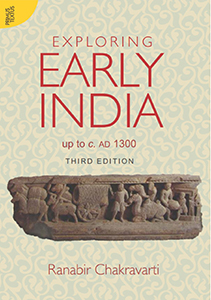
Exploring Early India Up to c. AD 1300: (Third Edition)
AUTHOR- Ranabir Chakravarti
| PB ₹395 . $29.95 . ₤19.95 |
e-Book ₹295 . $26.95 . ₤17.95 |
|
INFORMATION
- AUTHOR : Ranabir Chakravarti
- PB ISBN : 978-93-84082-67-3
- EBOOK ISBN : 978-93-84092-13-9
- PB Year : 2016, EBOOK Year: 2017
- Extent : xxiv + 492 pp.
- Discount available on checkout
- Usually dispatched within 3 to 5 working days.
Exploring Early India Up to c. AD 1300
| HB ₹ 320 . $ . ₤ |
PB ₹ . $ . ₤ |
|
| POD ₹ . $ . ₤ |
e-Book ₹ . $ . ₤ |
INFORMATION
- AUTHOR – Ranabir Chakravarti
- ISBN – 978-93-84082-67-3
- Year – 2016
- Extent: 400 + 40 coloured illustrations
- 10% discount + free shipping
- Usually dispatched within 3 to 5 working days.
Exploring Early India up to c. AD 1300 offers a broad overview and connected narrative of early Indian history, taking into consideration major historical developments from the earliest times to c. AD 1300. Salient features of political, socio-economic and cultural history have been highlighted and discussed in great detail, and regional diversities in early Indian history have been commented upon keeping sight of commonalties at the subcontinental level. Rich in empirical details and containing relevant illustrations and maps, the book also offers critical readings of diverse primary sources such as field-archaeological, epigraphic, numismatic, textual and art-historical, and refers to various congruent, and contesting, images of the past which they generate. On the whole, it delves into the historiographical thrusts and shifts in the study of early India and is marked by attempts to demonstrate elements of change in early Indian history beyond dynastic shifts. This is the third edition of the book, and includes two new appendices on seafaring to the island of Socotra in light of recently discovered epigraphic data.
The Author
Ranabir Chakravarti is Professor of Ancient History, Centre for Historical Studies, Jawaharlal Nehru University, Delhi. He specializes in social and economic history of early India with a particular interest in Indian Ocean maritime history. His recent publications include Indo-Judaic Studies in the Twenty-first Century: A View from the Margin (2007), Exploring Early India (2012), and the Bangla treatise Bharat – Itihaser Adiparva (History of Ancient India up to AD 600), which has been translated in Hindi as Bharat – Itihas ka Adi Kal (2012). He is also a regular contributor to refereed Indian and international journals.
Exploring Early India up to c. AD 1300 offers a broad overview and connected narrative of early Indian history, taking into consideration major historical developments from the earliest times to c. AD 1300. Salient features of political, socio-economic and cultural history have been highlighted and discussed in great detail, and regional diversities in early Indian history have been commented upon keeping sight of commonalties at the subcontinental level. Rich in empirical details and containing relevant illustrations and maps, the book also offers critical readings of diverse primary sources such as field-archaeological, epigraphic, numismatic, textual and art-historical, and refers to various congruent, and contesting, images of the past which they generate. On the whole, it delves into the historiographical thrusts and shifts in the study of early India and is marked by attempts to demonstrate elements of change in early Indian history beyond dynastic shifts. This is the third edition of the book, and includes two new appendices on seafaring to the island of Socotra in light of recently discovered epigraphic data.
The Author
Ranabir Chakravarti is Professor of Ancient History, Centre for Historical Studies, Jawaharlal Nehru University, Delhi. He specializes in social and economic history of early India with a particular interest in Indian Ocean maritime history. His recent publications include Indo-Judaic Studies in the Twenty-first Century: A View from the Margin (2007), Exploring Early India (2012), and the Bangla treatise Bharat – Itihaser Adiparva (History of Ancient India up to AD 600), which has been translated in Hindi as Bharat – Itihas ka Adi Kal (2012). He is also a regular contributor to refereed Indian and international journals.
Table of Contents
Table of Contents
| Transliteration Table | ix |
| Preface to the Third Edition | xi-xii |
| Preface to the First Edition | xiii-xiv |
| Author’s Note to the Second Edition | xv |
| Abbreviations | xvii |
| Introduction | xix-xxiv |
| From the Beginning of Human Presence to the First Civilization (Up To C.1500 BC) | 1-43 |
| India During the Days of the Vedic Corpus (C.1500-600 BC) | 44-82 |
| Mahajanapadas, Urban Centres and Heterodox Religious Movements (C.600–300 BC) | 83-124 |
| The Maurya Empire (C.325 BC–185 BC) | 125-178 |
| Confrontations, Commerce and Cultural Scenario (C.200 BC–AD 300) | 179-246 |
| A Political, Social and Cultural Overview: The Epoch of the Guptas and their Contemporaries (AD 300–600) | 247-315 |
| Realms and Regions: Profiles of Economy, Society and Culture (C. AD 600–1300) | 316-422 |
| Appendix I | 423-453 |
| Appendix II | 454-460 |
| Bibliography | 461-475 |
| Index | 477-491 |




